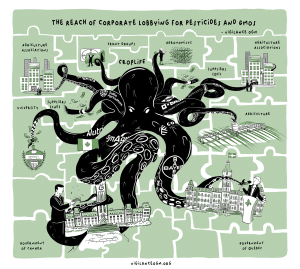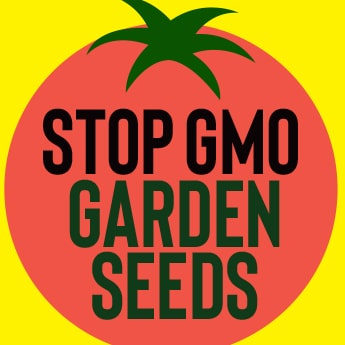Map of Corporate Lobbying on GMOs and Pesticides
The Reach of Corporate Lobbying for Pesticides and GMOs
November 28, 2024: Map of GMO and pesticide lobbying unveiled at Parliament Hill. 
The Quebec network Vigilance OGM (GMO Watch) has developed an interactive map in French that shows the reach of corporate lobbying to promote GMOs and pesticides in Canada. In the map, a giant octopus with many arms represents the reach of corporate lobbying to influence all stakeholders. This corporate influence is extended through agronomists, agriculture associations, front groups or “fake NGOs”, seed and pesticide dealers, and by the federal and provincial governments themselves.
- The full interactive mapping tool is available online in French.
- The static graphic of the map is posted in English here.
Below is a preliminary description of the details behind the map.
The Scandals
A number of public scandals have revealed the extent of the corporate influence in government decision-making. These are just three examples:
- An October 2024 investigative report found that government regulators staved off a pesticide ban by helping Bayer undermine a study that shows high levels of neonicotinoid contamination in wetlands.
- In September 2023, documents received via Access to Information showed that CropLife Canada worked in a joint committee with federal government departments called the “Tiger Team” to remove government regulation, including government safety assessments, from many new GMOs. For more information see cban.ca/NoExemptions
- In July 2023, Dr. Bruce Lanphear, a physician and professor at Simon Fraser University in British Columbia, resigned from Health Canada’s Pesticide Management Regulatory Agency scientific advisory committee because of a lack of transparency in government decision-making over pesticide safety, and the lack of attention to independent scientific data.
Corporate Influence
Vigilance OGM finds that:
- The biotechnology and pesticide industry lobby group CropLife and its corporate members wield disproportionate influence over government to promote the interests of the biotechnology and pesticide industry, at the expense of the public good. Vigilance OGM argues that the federal government’s leniency toward corporate demands amounts to regulatory capture by corporate interests.
- There is a “revolving door” that means key leadership positions at CropLife are held by former senior officials from Health Canada, the Canadian Food Inspection Agency (CFIA), and Agriculture Canada.
- The frequency of recorded meetings between government and corporate lobbyists represents only a fraction of government-corporate interactions.
The mapping tool sheds light on some of the ways that corporate interests are amplified across the agriculture industry and broader society.
For example, the industry exerts its influence through other organizations, by sitting on boards of directors or becoming members of agricultural associations.
The industry also creates front groups or “fake” NGOs, which can also receive funding from the Canadian government. For example, the charity called the Canadian Centre for Food Integrity (CCFI) has a mission to create “public trust” in the food system but its membership includes the biggest pesticide and biotechnology companies in the world. The CCFI researchers public opinion on GMOs and pesticides and creates public education initiatives such as “It’s Good Canada” that combines recipes along with articles that minimize the health risk of pesticides and promote gene editing, and features interviews with CropLife employees.
CropLife has a website called “Nature Nurtured” to promotes the new genetic engineering techniques of gene editing, which it calls “plant breeding”, to the Canadian public. The website refers to gene editing as a “proven solution” even though there are no gene edited products yet on the market in Canada, for example.
Click here for more information on these corporate initiatives.






